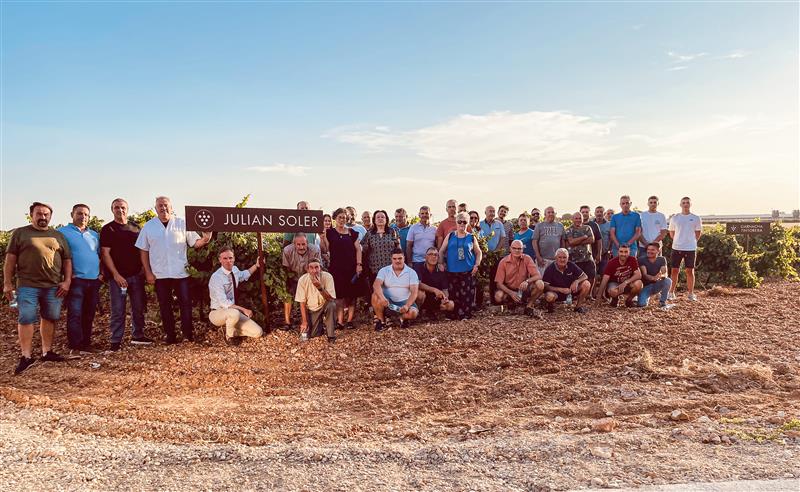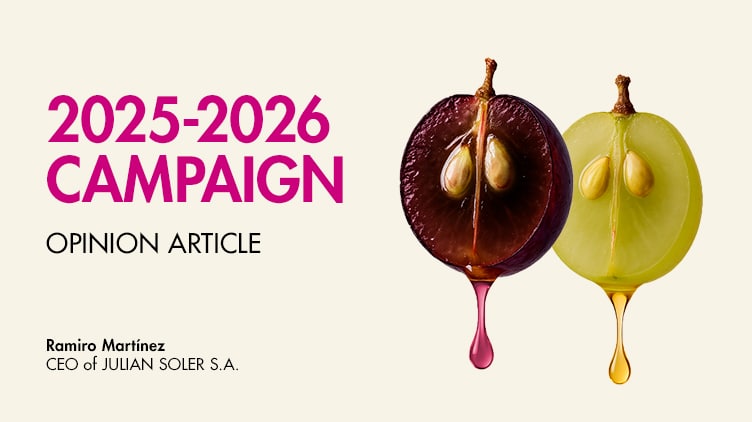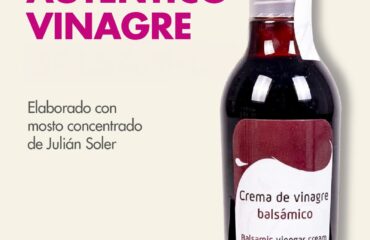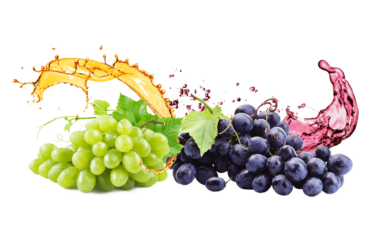Figures and commitment shape the present; consistency builds the future
Opinion article – Grape harvest Campaign 2025-2026 – By Ramiro Martínez – CEO of JULIAN SOLER S.A.
ON THE VERGE of a new harvest, which is expected to be of high quality despite the climatic challenges, already underway in some areas of Spain with early varieties such as Chardonnay, Muscat and Sauvignon Blanc, a few days behind last year, and figures that would bring us closer to a somewhat more generous campaign than the previous ones, according to the latest estimates from the cooperative production sector Cooperativas Agro-alimentarias de Castilla-La Mancha, which forecasts a total national volume of 38 million hectolitres (Mhl) between wine and must in this upcoming 2025 harvest, with a regional contribution from Castilla-La Mancha of around 24 Mhl (6% higher than the 2024/25 regional harvest, which makes it easy to imagine that the national total could be slightly above 40 Mhl if the figure for Castilla-La Mancha is confirmed based on the weather conditions of recent weeks). WE MUST NOT FORGET the efforts of those who have facilitated the previous difficult harvests: FARMERS, the leading representatives of our primary sector, who have continued to cultivate grapes and diversify their use among different industries (wines, musts, vinegars, alcohols), either by delivering them to private wineries (who know their end use) or through cooperative decisions via the growing and professionalised Spanish cooperative model.
The MIXED MODEL for raw material input that we have been working on at JULIAN SOLER since
1968, with grapes from more than 300 farmers in La Manchuela, Cuenca, together with constant
cooperation with more than 70 cooperatives and private wineries for the production of sulphurised red and white musts to be concentrated in our evaporators, thus obtaining more than 40,000 tonnes/year of concentrated must (equivalent to around 200 million kilos of grapes), gives us a very complete picture of the evolution and effort of those who are at the heart of our business, the winegrowers, the grape farmers, especially those with a predominance of red varieties in recent years.
As anticipated, this new campaign appears to present MORE ENCOURAGING FIGURES in general
terms of quality and volume, not only in Spain but also in the other two major European producers, Italy and France. The 2025 harvest forecast for Italy is in line with the average for recent years, with an initial production estimate of 45 million hectolitres (2% higher than the previous 43.97 MHL – Coldiretti / AGEA), with varying performance across regions, but with significant growth in important areas for must, such as Puglia (+20%). In France, the harvest is showing a strong recovery, with a forecast volume of between 41-42 MHL (+17%), after recording the lowest harvest in more than six decades in 2024 (AGRESTE).
On the European continent, the odd note would be in Portugal, with a harvest that would provisionally be around 6.2 Mhl (IVV), which represents a decrease of 11% compared to 2024 and 12% below the average of the last five seasons, mainly due to the unstable spring weather that favoured the development of mildew.
In the southern hemisphere, without going into detail, with its two major producers, Argentina for
white musts and Chile for red musts, and with the campaigns now over, we could summarise the
situation as stable with positive volumes in the case of Argentina (INV), and, conversely, lower production than initially forecast in the case of Chile (ANIAE) due to the lower yield observed in red varieties once the harvest was widespread.
Delving deeper into the forecast for the Spanish harvest, and similarly taking into account the differentiation of colours in the style of Argentina (white) and Chile (red), it would not be fair to
expand on comments without differentiating by colour for the equally diverse national production, as there are very different realities between red and white grapes when we consider their destination as concentrated and direct grape juice, as in the world of wine, not all grape varieties contribute the same and, therefore, should not be valued equally.
However, we could interpret both realities, if I may, following the precepts of the renowned 19th-century English naturalist and scientist CHARLES DARWIN and his Theory of Evolution, which answers how species transform and adapt over time.

Darwinism is based on the central idea of NATURAL SELECTION, in which species evolve over time as a result of genetic variation and those traits that give individuals ADAPTIVE ADVANTAGES in a specific environment. Natural selection therefore takes into account competition in a natural environment with limited resources, where natural conditions themselves benefit certain individuals based on the characteristics they possess. Over successive generations, the frequency of genes associated with these traits increases, leading to the adaptation of the population to its environment to ensure its survival.
The QUALITY DEMANDED by national and international customers of Spanish grape juice concentrate has naturally led to the selection of the red varieties BOBAL and TINTORERA from La Manchuela, and the white variety AIRÉN from La Mancha, as the most suitable grapes for the production of high-quality red and white concentrated musts.
However, the decision to not only continue growing these grapes but also to DIVERSIFY THEIR USES OR DESTINATIONS, between wine, must, vinegar and alcohol, is probably, according to Darwin, another of those beneficial traits that confer adaptive advantages in a specific environment and which, in the case of grape growers and/or their respective cooperatives, can guarantee survival in any scenario. In the case at hand, increasingly frequent irregular production scenarios (shortages vs. surpluses) and/or changing market situations (with changes in consumption patterns, wars, tariffs, etc.) have been repeatedly and, probably with greater intensity, affecting the production and marketing of wine products in recent years.
The reality of the recently completed 2024 agricultural year in Spain has not been unfavourable in general terms of volume for the white Airén variety, although there is room for improvement in terms of the final Brix-Baumé degree harvested, with the consequent increase in processing costs for grape juice concentrate producers supplying the juice, food and beverage industries, together with the continuing trend of high prices for white wines and musts for winemaking as a result of consumer demand for these products. Italy improved its figures in 2024 compared to the very low harvest of 2023, and in 2025 it is expected to improve again and reach average harvest figures. Given this scenario, Italy’s expected demand from the Spanish market in the upcoming 2025 season should continue to be lower than in the previous 2024 harvest, where there was already less pressure or need for supply, mainly in standard or conventional quality. Special qualities such as Free So2 or virgin must, organic/bio, sustainable, baby food, etc., where Italy continues to have a deficit, deserve a different analysis.
In this scenario of continued positive production volumes for Airén in Spain in 2025, and hopefully also of the desired quality, the strength of demand and the price of white wine (including white musts for winemaking) is the main factor determining the price of sulphurised white musts and, therefore, their concentrated and rectified musts, even above the influence of the price of other concentrates from other fruits that are interchangeable in some uses with grapes, such as apples, whose production is estimated to be stable at the European Union level for this 2025 harvest compared to the previous one (WAPA), although it remains 7.5% lower than the average for the last 3 years.
Switching to red wine, focusing on the varieties best suited to our Darwinian vision for grape juice concentrate, the Bobal and Tintorera grapes from La Manchuela have experienced a very different reality to that of their white neighbour, Airén. Yields more than 50% lower than average in 2023, or 15% lower than average in the last harvest in 2024, with a particular decline in the case of the Bobal variety, have tested the resilience of traditional suppliers of these two varieties of red must grapes, who have continued to focus on must production and assert their efforts and strategic vision towards diversification in order to continue building the future, encouraged not only by the general difficulty in marketing red wines, even those of other varieties, but also by their commitment to the food and beverage industry, which JULIAN SOLER serves. Thanks to all of them.
2024 has been a year of reduced red wine stocks, with stored batches being sold off and a certain amount
of everything sold out, including volumes that had been delayed in their withdrawal due to market apathy. All this has been accompanied by a slight positive upturn in the price of red wines in the latter part of the season.
Given this outlook, the new 2025 season for red wines, with an expected volume closer to an average harvest, would once again balance the ratio of red grapes destined primarily for wine and must, in sufficient quantities to maintain, without stress, both the replenishment of the volumes of red wine to be produced, which are expected to be higher as a result of lower final stocks, and the quantities necessary to continue the niche market for concentrated red must, as has been the case in previous, more depleted harvests.
The effort and commitment of these small harvests in La Manchuela, where the structural costs of mainly medium-sized farmers and cooperatives, with their bobales and tintoreras, have been greatly affected, we hope will now receive a lifeline with the, a priori, more comfortable 2025 harvest and be able to continue not only with their commitment, but also with the perseverance to continue seeking quality in their harvests and to assert the adaptive advantage of their varieties, thus guaranteeing the Darwinian survival of their farms and cooperatives. Given this, a scenario of continuity in terms of volumes and prices, as far as our must business is concerned, seems the most likely scenario, if weather conditions allow for a normal harvest.
The evolution and competition in the MARKET, the standardisation of qualities, the automation of processes… sometimes cause us to forget the most basic and relevant aspect, which is the ORIGIN, the grape, or rather THE GRAPES, as not all are the same, as we have said, just as the quality requirements of customers are not the same, who demand competitive concentrated musts of standardised quality but within the uniqueness of their own recipes or end uses, which in turn could seem contradictory, standardisation vs. uniqueness, or at least not easily achievable without consistency in quality and sufficient supply of raw materials for the proper execution of a well-defined industrial process that allows for this STANDARDISED UNIQUENESS to be obtained, always with the quality demanded by customers in the changing environment of each harvest.
Here, the CUSTOMER of concentrated must, and their expectations in terms of quality, volume and target price at the beginning of each season, also play a decisive role in the desirable balance of all those who form part of this value chain, where the foundation, farmers, provide the rest of us with the raw materials we need to work with, facing their own challenges unrelated to ours in the market, such as the difficulty of finding labour for agricultural work, generational renewal, the upcoming redefinition of the CAP, among others. All these challenges, when there is insufficient remuneration or price, or a lack of sugar, are more bitter and difficult to digest.
At JULIAN SOLER, the focus has always been, in the words of our founder, on conceiving ‘the company as the main instrument of service to society’, especially in La Manchuela and the region of Castilla-La Mancha where we are located. Providing STABILITY both to our suppliers, in the collection of the raw material produced and committed, and to our customers, in their demand for a year-round supply of a product made ‘to order’, even in the most difficult market, volume or quality circumstances. Generating a long-term relationship and loyalty where trust and certainty, both in collection and supply, are renewed year after year, being the most valued on multiple occasions, even above the price differential that could be obtained if operating in a more speculative manner, especially when the market finally aligns prices. Or should it not continue to be important to minimise the risk of having raw material deposits that are not withdrawn on the agreed date or to avoid suffering a stoppage due to a lack of concentrated must in the production line of any of our customers’ recipes?… and all this while remaining attentive to new trends and market requirements in order to adapt our technological and human investments to the most demanding qualities demanded by customers within their own Darwinian evolution (low SO2, free SO2, high red colour, sustainable, ecological, baby food, low white colour, etc.).
When we talk from the perspective of marketing or commercialisation strategies, we quickly understand the concept of ‘working globally from a local perspective’ or, in other words, “THINK GLOBALLY, ACT LOCALLY“, which involves adapting global strategies to the peculiarities of the local environment, seeking a balance between standardisation and customisation to ensure that the product or business is adapted to local characteristics (style, language, economy, culture, etc.), and thus guaranteeing its success and survival.
However, this approach is often forgotten in the primary sector when we speak from the perspective of the producer or supplier of agricultural raw materials, tending to globalise their peculiarities, ‘acting globally’ with comparisons to realities (in this case, grape varieties or decisions on their destination/end use) that are very different from their own, and which hinder the survival of their business model.
We should probably act more locally, attending to and facilitating ‘THE SURVIVAL OF THE FITTEST’, a phrase first used by Darwin in the 5th edition of his work The Origin of Species, published in 1869, ten years after the initial edition. Those who have been able to adapt to the environment with strategic decisions to ensure the availability of the most suitable varieties for the quality of our concentrated and direct grape juices, as well as their constant volume, thanks to the diversification of the final destination of their grapes year after year, and which guarantee that we will continue to have adequate and sufficient raw materials to continue building the future of all of us who are part of this value chain with the greatest possible certainty. Once again, a new harvest gives us another opportunity to act.
There are decisions and advice that can only be understood with the passage of time, and even then, they do not necessarily have to be shared, although they should always be respected.
As we discussed at JULIAN SOLER in one of our recent meetings with some of our winegrowers to prepare for this season, THE DIFFICULT THING IS NOT TO SAY WHAT YOU DO, BUT TO DO WHAT YOU SAY.
Let’s see how this 2025/26 campaign unfolds, what everyone involved (farmers, cooperatives, industrialists, customers) ‘does’ and ‘says’ in it, and how we face our own Darwinian evolution.
HAVE A GOOD HARVEST IN 2025!
Download the full article here >> 2025-2026 HARVEST REPORT





 by
by